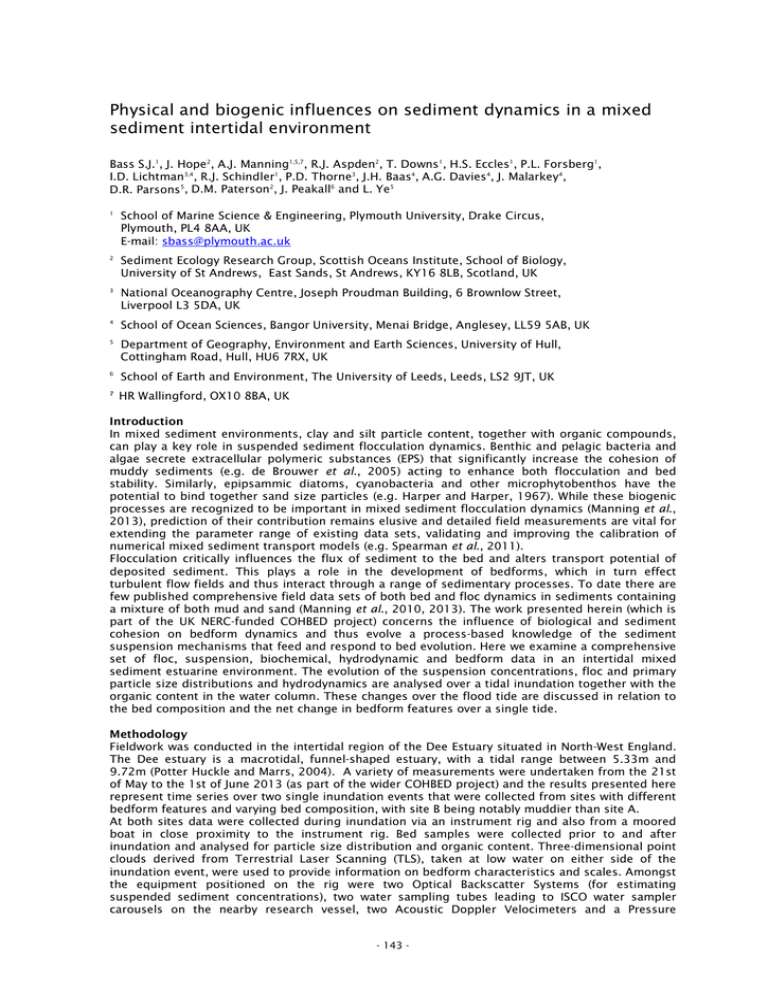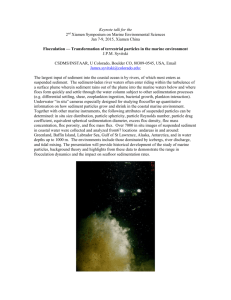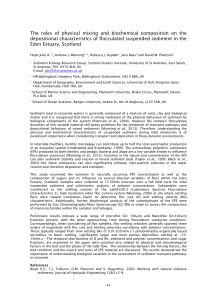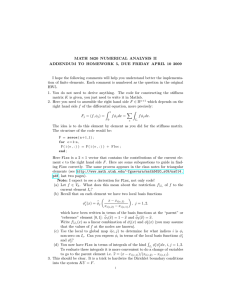Physical and biogenic influences on sediment dynamics in a mixed
advertisement

Physical and biogenic influences on sediment dynamics in a mixed sediment intertidal environment Bass S.J.1, J. Hope2, A.J. Manning1,5,7, R.J. Aspden2, T. Downs1, H.S. Eccles1, P.L. Forsberg1, I.D. Lichtman3,4, R.J. Schindler1, P.D. Thorne3, J.H. Baas4, A.G. Davies4, J. Malarkey4, D.R. Parsons5, D.M. Paterson2, J. Peakall6 and L. Ye5 1 School of Marine Science & Engineering, Plymouth University, Drake Circus, Plymouth, PL4 8AA, UK E-mail: sbass@plymouth.ac.uk 2 Sediment Ecology Research Group, Scottish Oceans Institute, School of Biology, University of St Andrews, East Sands, St Andrews, KY16 8LB, Scotland, UK 3 National Oceanography Centre, Joseph Proudman Building, 6 Brownlow Street, Liverpool L3 5DA, UK 4 School of Ocean Sciences, Bangor University, Menai Bridge, Anglesey, LL59 5AB, UK 5 Department of Geography, Environment and Earth Sciences, University of Hull, Cottingham Road, Hull, HU6 7RX, UK 6 School of Earth and Environment, The University of Leeds, Leeds, LS2 9JT, UK 7 HR Wallingford, OX10 8BA, UK Introduction In mixed sediment environments, clay and silt particle content, together with organic compounds, can play a key role in suspended sediment flocculation dynamics. Benthic and pelagic bacteria and algae secrete extracellular polymeric substances (EPS) that significantly increase the cohesion of muddy sediments (e.g. de Brouwer et al., 2005) acting to enhance both flocculation and bed stability. Similarly, epipsammic diatoms, cyanobacteria and other microphytobenthos have the potential to bind together sand size particles (e.g. Harper and Harper, 1967). While these biogenic processes are recognized to be important in mixed sediment flocculation dynamics (Manning et al., 2013), prediction of their contribution remains elusive and detailed field measurements are vital for extending the parameter range of existing data sets, validating and improving the calibration of numerical mixed sediment transport models (e.g. Spearman et al., 2011). Flocculation critically influences the flux of sediment to the bed and alters transport potential of deposited sediment. This plays a role in the development of bedforms, which in turn effect turbulent flow fields and thus interact through a range of sedimentary processes. To date there are few published comprehensive field data sets of both bed and floc dynamics in sediments containing a mixture of both mud and sand (Manning et al., 2010, 2013). The work presented herein (which is part of the UK NERC-funded COHBED project) concerns the influence of biological and sediment cohesion on bedform dynamics and thus evolve a process-based knowledge of the sediment suspension mechanisms that feed and respond to bed evolution. Here we examine a comprehensive set of floc, suspension, biochemical, hydrodynamic and bedform data in an intertidal mixed sediment estuarine environment. The evolution of the suspension concentrations, floc and primary particle size distributions and hydrodynamics are analysed over a tidal inundation together with the organic content in the water column. These changes over the flood tide are discussed in relation to the bed composition and the net change in bedform features over a single tide. Methodology Fieldwork was conducted in the intertidal region of the Dee Estuary situated in North-West England. The Dee estuary is a macrotidal, funnel-shaped estuary, with a tidal range between 5.33m and 9.72m (Potter Huckle and Marrs, 2004). A variety of measurements were undertaken from the 21st of May to the 1st of June 2013 (as part of the wider COHBED project) and the results presented here represent time series over two single inundation events that were collected from sites with different bedform features and varying bed composition, with site B being notably muddier than site A. At both sites data were collected during inundation via an instrument rig and also from a moored boat in close proximity to the instrument rig. Bed samples were collected prior to and after inundation and analysed for particle size distribution and organic content. Three-dimensional point clouds derived from Terrestrial Laser Scanning (TLS), taken at low water on either side of the inundation event, were used to provide information on bedform characteristics and scales. Amongst the equipment positioned on the rig were two Optical Backscatter Systems (for estimating suspended sediment concentrations), two water sampling tubes leading to ISCO water sampler carousels on the nearby research vessel, two Acoustic Doppler Velocimeters and a Pressure - 143 - Transducer. To obtain measurements of floc size (D) and settling velocity (Ws) distributions a water sample was collected using a 2.2L Van Dorn horizontal water sampler every fifteen minutes during the flood and ebb. Sub-samples from the Van Dorn sampler were extracted via a modified pipette and transferred separately to a low intrusion, video-based laboratory spectral flocculation characteristics (LabSFLOC) instrument (Manning, 2006) for instant data analysis. Indications of individual floc effective density (ρ eff ) and floc mass were be determined. The two ISCO water samplers, containing 24 bottles each, were automated to collect three 500ml replicates of water every ten minutes over both the flood and ebb tide. Samples were collected for suspended mass concentration, EPS content (spectrophotometric methods), and for laser particle sizing. Representative floc populations were carefully extracted from the Van Dorn using a modified pipette and then transferred to the LabSFLOC settling column, whereby settling flocs were viewed by a high resolution digital video camera, (resolution ~10µm) from which size and settling velocity distributions were estimated. Results Peak current speeds reached a nominal value of 0.6m/s during the flood at both site A and site B. The ambient flow produced maximum near bed turbulent shear stresses of ~0.25Pa. However, the point clouds data from the TLS taken at both sites indicates that bedforms at site B are both smaller in scale and underwent less net change over a single tide than those at site A. Despite similar hydrodynamic conditions and primary particle size at the two sites, suspended sediment concentrations (SSC) from the muddier site indicate higher near bed concentrations (SSCs of 118466mg/l on 25th May 2013 compared to 56-215mg/l on 20th May 2013 during floc sampling at sites A and B, respectively) and greater suspended sediment stratification. A total of 67 LabSFLOC-2 populations were collected. Tables I and II summarise key parameterized floc properties for run and sub-run timescales at Sites A and B. While mean floc properties varied little at both sites, slightly higher mean floc size and a higher percentage of macroflocs (D > 160µm) were observed alongside the higher sediment concentrations at the muddier site (site B). Initial biochemical results suggest that over the period of tidal inundation there was relatively little temporal variation of organic matter, while primary particle size analysis indicates that the relative proportions of silt to sand increased over the slack high water period as expected with the concomitant decrease in turbulent shear. Further biochemical analyses of the bed composition and suspension will be used to compare the temporal evolution of bed and suspension characteristics before, during and after inundation and mechanisms contributing to these characteristics will be discussed in relation to the two different sites. Table I. Floc property ranges and average Macrofloc content for Site A (25th May 2013) and Site B (29th May 2013) Table II. Total run and sub-run average floc properties for Site A (25th May 2013) and Site B (29th May 2013) References De Brouwer J.F.C., K. Wolfstein, G.K. Ruddy, T.E.R. Jones and L.J. Stal. 2005. Biogenic stabilization of intertidal sediments: the importance of extracellular polymeric substances produced by benthic diatoms. Microbial Ecology 49(4):501-512. - 144 - Harper M.A. and J.F. Harper. 1967. Measurements of diatom adhesion and their relationship with movement. British Phycological Bulletin 3:195-207. Manning A.J. 2006. Labsfloc - a laboratory system to determine the spectral characteristics of flocculation cohesive sediments. Report TR 156. Release 1.0. HR Wallingford. p.1–13. Manning A.J., J.V. Baugh, J.R. Spearman and R.J. Whitehouse. 2010. Flocculation settling characteristics of mud: sand mixtures. Ocean dynamics 60(2):237-253. Manning A.J., J.R. Spearman, R.J.S. Whitehouse, E.L. Pidduck, J.V. Baugh and K.L. Spencer. 2013. Laboratory assessments of the flocculation dynamics of mixed mud: sand Suspensions. p.119164, Chapter 6. In: Sediment Transport Processes and their Modelling Applications. Manning A.J. (Ed.). InTech, Rijeka, Croatia, ISBN: 978-953-51-1039-2. DOI: org/10.5772/3401. Potter Huckle and Marrs. 2004. Spatial and temporal changes in salt marsh distribution in the Dee Estuary, NW England, determined from aerial photographs. Wetlands Ecology and Management. p.483-498. Spearman J.R., A.J. Manning and R.J.S. Whitehouse. 2011. The settling dynamics of flocculating mud: sand mixtures: Part 2 – Numerical modelling. Ocean Dynamics 61:351-370. DOI: 10.1007/s10236-011-0385-8. - 145 -






